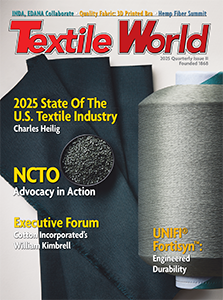BRUSSELS — May 4,2017 — Exhibition space application for ITMA 2019, the world’s largest textile and garment technology exhibition, opens today. The exhibition, which has been held every four years since 1951, showcases the entire textile and garment making manufacturing chain, as well as raw materials.
As the most established industry exhibition, ITMA’s owner, CEMATEX – the European Committee of Textile Machinery Manufacturers – constantly reviews its index of products to ensure its relevance and continuously improve visitor experience.
Fritz P. Mayer, president of CEMATEX, explained: “A core value of ITMA is to be relevant to the textile and garment making industry and end-users. As such, we are always exploring new ways to reinvent and to make our platform vital to all stakeholders by offering an integrated sourcing experience. More importantly, during every ITMA, manufacturers are able to have meaningful discussions with their partners and customers on innovative ideas that offer users a competitive advantage.”
At ITMA 2011 a new fibre and yarn sector was introduced, and this was favourably received by visitors who could source their raw materials at the show. Due to the favourable response received from fibre and yarn exhibitors and visitors at the last two ITMA shows, ITMA 2019 will include woven, nonwoven and knitted fabrics in the fibre and yarn exhibit sector. In addition, digital and screen printing inks have been classified in the printing chapter. This will allow ink producers to be in the same hall as printing machinery manufacturers so that visitors can easily source technology and consumables. A new service introduced for the benefit of machinery buyers is leasing and financing services, according to ITMA Services, the organiser of ITMA 2019.
Mr A. E. Roberts, managing director of ITMA Services, commented, “We have taken a comprehensive approach in ensuring the index of products will be extremely useful to manufacturers as the global business environment remains challenging. The launch of ITMA 2019 space application has been eagerly awaited by textile machinery manufacturers and raw material producers. We have received a lot of enquiries from past exhibitors and interested manufacturers who have not taken part in ITMA before. This augurs well for ITMA 2019 and the industry can look forward to another strong industry platform.”
Mr Han Bekke, president of International Apparel Federation, said: “ITMA is a very established textile machinery exhibition but over the years, the exhibition show profile has evolved in keeping with industry trends and challenges. It now features the entire textile and garment making production chain, including raw materials.
“Hence, our IAF members which represent the world’s leading brands and apparel makers find it an excellent sourcing platform. As we look for innovative solutions to offer consumers exciting products made in a sustainable way, we are glad to be able to explore new materials and technologies in one location at ITMA 2019.”
ITMA 2019 will be held from 20 to 26 June at Fira de Barcelona, Gran Via venue. Interested participants can visit www.itma.comto apply for space or get more information on the sector allocation plan, exhibition schedule and travel arrangements.
Mr Jordi Galtés, president of AMEC AMTEX, the Spanish Association of Textile Machinery Manufacturers, enthused: “We are excited to be hosting ITMA again. Participants had a good experience in 2011 and we hope to replicate it again in 2019. Spain is home to some of the most famous luxury and fast fashion brands and an interesting destination for all in the textile, garment and fashion industry.”
The last ITMA exhibition, held in Milan in 2015, featured exhibits from the entire textile and garment making value chain spread over 108,268 square metres of net exhibition space. It drew the participation of 1,691 exhibitors from 46 countries and visitorship of almost 123,000 from 147 countries.
Posted May 4,2017
Source: CEMATEX & ITMA Services




